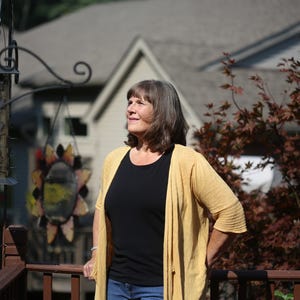Late Friday afternoon on Dec. 4, 2014, Stephen Schroeder was waiting to board his packed flight from Philadelphia to Las Vegas for a much anticipated long weekend with his son when his cellphone rang. On the line was an unexpected caller: his doctor, reporting test results sooner than Schroeder had expected.
Listening intently, Schroeder was flooded with disbelief as he struggled to comprehend what he was hearing. Using the lip of a trash can as a writing surface, he scribbled notes on the back of his boarding pass, making the doctor spell out each unfamiliar word. Then he sent a terse text to his wife, who was at their home in the Philadelphia suburbs, and got on the plane.
Onboard, Schroeder, then 55, fired up the balky in-flight Internet, desperate for information.
What he read over the next five hours left him alternately terrified, stunned and then, as denial took over, skeptical. “I kept thinking this must be some kind of really stupid mistake,” he recalled. “The diagnosis had to be wrong.”
Schroeder would discover that the pesky rash he and his doctors had dismissed as inconsequential would take over — and threaten — his life.
 Spokane sales manager Steve Schroeder, along with his doctors, thought he had a bad case of jock itch for more than a year. (Courtesy of Steve Schroeder)
Spokane sales manager Steve Schroeder, along with his doctors, thought he had a bad case of jock itch for more than a year. (Courtesy of Steve Schroeder)
The experience would provide a crash course in the importance of finding experts who could provide appropriate treatment, in the necessity of learning as much as possible about a disease, and in the loneliness of coping with a diagnosis so rare it lacks a support group.
A case of jock itch
In the fall of 2013, Schroeder noticed a small, purplish pimple on his groin. “I was pretty sure it was an ingrown hair, so I ignored it for six months,” figuring it would go away on its own, he recalled. The pimple disappeared, replaced by a dime-size red, scaly rash on his scrotum. Schroeder said he assumed it was
jock itch — vernacular for a common fungal infection of the groin — and did nothing for several more months.
“I’m a guy,” he said. “It didn’t faze me much.” The director of membership development for a purchasing cooperative, Schroeder had been successfully treated for
melanoma, the deadliest form of skin cancer, in 1989. He had not had a recurrence and was always vigilant about annual checkups.
In the spring of 2014, as his primary-care doctor was on her way out the door after a routine appointment, Schroeder said he remembered the red patch “almost as an afterthought” and mentioned it.
She examined the spot, agreed it looked like jock itch and suggested he try the standard treatment: an over-the-counter antifungal cream. Several weeks later, when the problem remained, Schroeder returned. His physician and one of her partners took a look and prescribed a stronger antifungal medicine.
“They both agreed it was nothing to worry about,” Schroeder recalled. “It wasn’t painful, just annoying” and itchy.
The second medicine was no more effective than the first. Schroeder then consulted his dermatologist. He, too, initially agreed it was a stubborn fungal infection, which thrives in moist, dark areas of the body. Later, the dermatologist changed his mind and suspected
eczema, a skin inflammation that causes redness and itching. Another possibility, he told Schroeder, was that he had developed
contact dermatitis, a common allergic reaction to the shampoo, soap or fabric softener he used.
Schroeder thought that was odd, but he changed his shampoo and soap brands and stopped using fabric softener. “I think he was winging it as he went,” Schroeder said of his dermatologist. The rash didn’t improve.
Fifteen months after the first symptom and a few days before his Las Vegas weekend, Schroeder returned to the dermatologist and asked him to perform a biopsy to determine the cause of the red patch.
“Steve, this is kind of weird,” he remembers the dermatologist saying when he answered his phone at the airport.
Searching for experts
The doctor told Schroeder that his “jock itch” was actually an extremely rare, invasive cancer called
extramammary Paget’s disease (EMPD), a malignancy that involves the
apocrine glands that produce sweat; it often affects the vulva, scrotum or penis.
The cause of the cancer is unknown and doctors don’t know whether family history plays a role; some EMPD patients have close relatives with breast cancer, as does Schroeder, whose mother battled the disease.
EMPD is slow-growing; a two-year delay between the appearance of the first symptoms and a definitive diagnosis is not uncommon, studies have found. One reason is that it lacks few hallmarks and mimics eczema and other benign skin disorders. In some cases, EMPD reflects an underlying cancer elsewhere in the body, but in other cases, including Schroeder’s, no other cancer can be detected.
If left untreated, EMPD can spread and become lethal. Only a few hundred cases have been reported worldwide, most of them in women over 50.
As Schroeder tried to absorb the news, the dermatologist told him that he knew nothing about EMPD. He recommended that Schroeder consult a plastic surgeon.
Once in-flight and online, Schroeder was aghast at what he read. “It said things like, ‘This is a death sentence,’ ” he recalled. “I was just freaking out. I spent a lot of time praying and a lot of time crying” as surreptitiously as possible. None of his fellow passengers or the flight crew said anything.
The plastic surgeon Schroeder consulted was no help; he told Schroeder he had never heard of EMPD. “I didn’t know how I was going to find the right people. It was a really scary time. I quickly tried to research who is the expert in this,” he said, but found little that was helpful.
Schroeder said it did not occur to him to call specialized hospitals. “I’d never heard of Sloan Kettering,” he said, referring to Memorial Sloan Kettering Cancer Center in New York, a hospital that would later loom large in his life.
“I felt like I was fighting the cancer battle myself. I learned to be inquisitive and to ask questions.” Schroeder called his dermatologist for help finding a doctor and was referred to Bradley D. Figler, then the director of reconstructive urology at Thomas Jefferson University in Philadelphia. He felt reassured when he learned that Figler was treating another man recently diagnosed with EMPD. In fact, Schroeder was the fourth EMPD patient Figler had seen in his 10-year career.
“The cases were all pretty similar,” said Figler, who is now an assistant professor of urology at the University of North Carolina School of Medicine. “They’re all middle-aged white guys.”
In January 2015, Schroeder underwent about eight hours of surgery at Thomas Jefferson to remove the large cancer, which had grown to encompass an area two inches by three inches and to rebuild his scrotum, using skin grafted from his left leg.
Figler said that the operation, which he performed with other specialists, involved
Mohs surgery, in which thin layers of skin are progressively removed and examined under a microscope by a pathologist until there is no detectable malignancy. The goal is to remove all cancer while minimizing damage to surrounding tissue. That is particularly tricky in EMPD cases, Figler said, because the cancerous cells often are not clumped together.
“He dealt with pretty radical surgery and a very significant recovery well and took it all in stride,” Figler said. “It’s really difficult to find expertise in this disease. He really sought it out.”
“I think this surgery is difficult on a lot of levels,” the surgeon continued. “Men get a lot of their self-image from this region.”
Figler said it is unclear whether Schroeder’s melanoma 25 years earlier played a role in the development of EMPD.
‘Like an octopus’
After Schroeder’s six-week recovery, the waiting began. Recurrence is the rule, not the exception. “This cancer is almost like an octopus,” he said.
Last year, Schroeder and his wife moved from Philadelphia to Spokane, Wash., to be closer to relatives. In October, he discovered another red patch, not far from the location of the first, and underwent a second surgery in Spokane, less extensive than the first.
One of his doctors pointed him to a study underway at Sloan Kettering involving a noninvasive imaging technique using confocal
microscopy, which may be able to detect some cancers earlier than usual and with more precision.
Schroeder enrolled in the study. Earlier this year, doctors there found three suspicious areas near the site of his original surgery, including on his leg; biopsies revealed EMPD in those locations. Two months ago, Schroeder underwent a third operation at the University of Washington in Seattle. He has returned to work and periodically flies to New York for testing as part of the study.
“I’m going to use whatever tools I can find at my disposal to try and keep this thing at bay,” he said.
One of the hardest aspects of his disease is the lack of a peer group. He has never talked to another person with EMPD but hopes to do so and has told his doctors to feel free to give his contact information to other EMPD patients. Schroeder set up a
Web page several months ago but so far has not heard from anyone. He says the love and support of his family, particularly his wife, has been essential in helping him recover.
Schroeder hopes his experience will serve as a cautionary tale. “Guys like to put stuff off,” he said. “If this convinces one guy to get something checked out, it’ll be worth it.”








